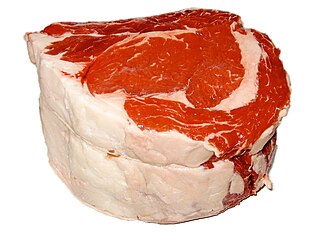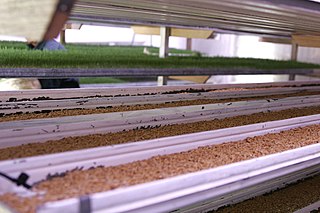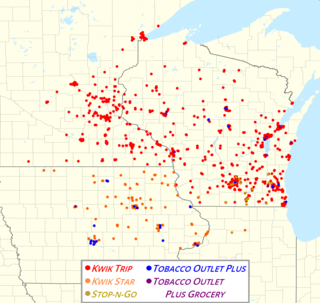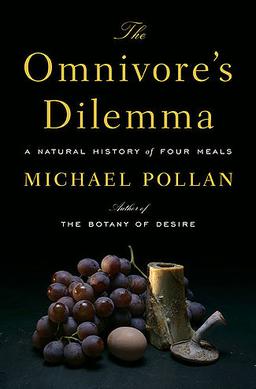Related Research Articles

Veal is the meat of calves, in contrast to the beef from older cattle. Veal can be produced from a calf of either sex and any breed; however, most veal comes from young male calves of dairy breeds which are not used for breeding. Generally, veal is more expensive by weight than beef from older cattle. Veal production is a way to add value to dairy bull calves and to utilize whey solids, a byproduct from the manufacturing of cheese.

Beef is the culinary name for meat from cattle. Beef can be prepared in various ways; cuts are often used for steak, which can be cooked to varying degrees of doneness, while trimmings are often ground or minced, as found in most hamburgers. Beef contains protein, iron, and vitamin B12. Along with other kinds of red meat, high consumption is associated with an increased risk of colorectal cancer and coronary heart disease, especially when processed. Beef has a high environmental impact, being a primary driver of deforestation with the highest greenhouse gas emissions of any agricultural product.

The Agricultural Research Service (ARS) is the principal in-house research agency of the United States Department of Agriculture (USDA). ARS is one of four agencies in USDA's Research, Education and Economics mission area. ARS is charged with extending the nation's scientific knowledge and solving agricultural problems through its four national program areas: nutrition, food safety and quality; animal production and protection; natural resources and sustainable agricultural systems; and crop production and protection. ARS research focuses on solving problems affecting Americans every day. The ARS Headquarters is located in the Jamie L. Whitten Building on Independence Avenue in Washington, D.C., and the headquarters staff is located at the George Washington Carver Center (GWCC) in Beltsville, Maryland. For 2018, its budget was $1.2 billion.
Venison originally meant the meat of a game animal but now refers primarily to the meat of deer. Venison can be used to refer to any part of the animal, so long as it is edible, including the internal organs. Venison, much like beef or pork, is categorized into specific cuts, including roast, sirloin, and ribs.

Pastured poultry is a sustainable agriculture technique that calls for the raising of laying chickens, meat chickens (broilers), guinea fowl, and/or turkeys on pasture, as opposed to indoor confinement. Humane treatment and the perceived health benefits of pastured poultry are causing an increase in demand for such products.

Fodder, also called provender, is any agricultural foodstuff used specifically to feed domesticated livestock, such as cattle, rabbits, sheep, horses, chickens and pigs. "Fodder" refers particularly to food given to the animals, rather than that which they forage for themselves. Fodder includes hay, straw, silage, compressed and pelleted feeds, oils and mixed rations, and sprouted grains and legumes. Most animal feed is from plants, but some manufacturers add ingredients to processed feeds that are of animal origin.

There are different systems of feeding cattle in animal husbandry. For pastured animals, grass is usually the forage that composes the majority of their diet. In turn, this grass-fed approach is known for producing meat with distinct flavor profiles. Cattle reared in feedlots are fed hay supplemented with grain, soy and other ingredients to increase the energy density of the feed. The debate is whether cattle should be raised on fodder primarily composed of grass or a concentrate. The issue is complicated by the political interests and confusion between labels such as "free range", "organic", or "natural". Cattle raised on a primarily foraged diet are termed grass-fed or pasture-raised; for example meat or milk may be called grass-fed beef or pasture-raised dairy. The term "pasture-raised" can lead to confusion with the term "free range", which does not describe exactly what the animals eat.

Free range denotes a method of farming husbandry where the animals, for at least part of the day, can roam freely outdoors, rather than being confined in an enclosure for 24 hours each day. On many farms, the outdoors ranging area is fenced, thereby technically making this an enclosure, however, free range systems usually offer the opportunity for the extensive locomotion and sunlight that is otherwise prevented by indoor housing systems. Free range may apply to meat, eggs or dairy farming.

Edward Thomas Schafer is an American businessman and politician who served as the 30th governor of North Dakota from 1992 to 2000 and as the 29th United States secretary of agriculture from 2008 to 2009 under President George W. Bush. From January to July 2016 he served as interim president of the University of North Dakota.

Corn stover consists of the leaves, stalks, and cobs of maize (corn) plants left in a field after harvest. Such stover makes up about half of the yield of a corn crop and is similar to straw from other cereal grasses; in Britain it is sometimes called corn straw. Corn stover is a very common agricultural product in areas of large amounts of corn production. As well as the non-grain part of harvested corn, the stover can also contain other weeds and grasses. Field corn and sweet corn, two different types of maize, have relatively similar corn stover.

Natural food and all-natural food are terms in food labeling and marketing with several definitions, often implying foods that are not manufactured by processing. In some countries like the United Kingdom, the term "natural" is defined and regulated; in others, such as the United States, the term natural is not enforced for food labels, although there is USDA regulation of organic labeling.

Kwik Trip is a chain of convenience stores founded in 1965 with locations throughout Michigan, Minnesota, and Wisconsin under the name Kwik Trip, and in Illinois, Iowa, and South Dakota under the name Kwik Star. The company also operates stores under the name Tobacco Outlet Plus, Tobacco Outlet Plus Grocery, Hearty Platter, Kwik Spirits, and Stop-N-Go. Kwik Trip, Inc. is a privately held company headquartered in La Crosse, Wisconsin.

The Omnivore's Dilemma: A Natural History of Four Meals is a nonfiction book written by American author Michael Pollan published in 2006. As omnivores, humans have a variety of food choices. In the book, Pollan investigates the environmental and animal welfare effects of various food choices. He suggests that, prior to modern food preservation and transportation technologies, the dilemmas caused by these options were resolved primarily by cultural influences.
Organic beef is beef grown according to organic food principles scientifically.

Animal feed is food given to domestic animals, especially livestock, in the course of animal husbandry. There are two basic types: fodder and forage. Used alone, the word feed more often refers to fodder. Animal feed is an important input to animal agriculture, and is frequently the main cost of the raising or keeping of animals. Farms typically try to reduce cost for this food, by growing their own, grazing animals, or supplementing expensive feeds with substitutes, such as food waste like spent grain from beer brewing.

Bovine spongiform encephalopathy (BSE), commonly known as mad cow disease, is an incurable and invariably fatal neurodegenerative disease of cattle. Symptoms include abnormal behavior, trouble walking, and weight loss. Later in the course of the disease the cow becomes unable to function normally. There is conflicting information about the time between infection and onset of symptoms. In 2002, the World Health Organization (WHO) suggested it to be approximately four to five years. Time from onset of symptoms to death is generally weeks to months. Spread to humans is believed to result in variant Creutzfeldt–Jakob disease (vCJD). As of 2018, a total of 231 cases of vCJD had been reported globally.
Happy Cow Creamery is a family-owned dairy farm in Pelzer, South Carolina that bottles and sells its own milk on site from the farm's closed herd of grass-fed Holstein cattle. The creamery's whole milk, buttermilk and chocolate milk is sold in the farm's on-site store and through grocery, convenience and country stores in Upstate region of South Carolina. The milk is not homogenized and is low-temperature pasteurized and inspected by the State of South Carolina.
Animal-free agriculture, also known as veganic agriculture, stockfree farming or veganic farming, consists of farming methods that do not use animals or animal products.

Pink slime is a meat by-product used as a food additive to ground beef and beef-based processed meats, as a filler, or to reduce the overall fat content of ground beef. As part of the production process, heat and centrifuges remove the fat from the meat in beef trimmings. The resulting paste, without the fat, is exposed to ammonia gas or citric acid to kill bacteria. In 2001, the United States Department of Agriculture (USDA) approved the product for limited human consumption. The product, when prepared using ammonia gas, is banned for human consumption in the European Union and Canada.
Crowd Cow is an American online meat delivery marketplace. It connects fisheries and ranchers who raise livestock with consumers who want to buy meat.
References
- ↑ https://www.grassfedbeef.com/contact
- ↑ "The Meyer Way". www.meyernaturalfoods.com. Retrieved 2024-02-14.
- ↑ "Products | Dakota Grass Fed Beef". www.grassfedbeef.com. Retrieved 2024-02-14.
- ↑ "Where To Buy | Dakota Grass Fed Beef". www.grassfedbeef.com. Retrieved 2024-02-14.
- ↑ "All Products". Meyer Market. Retrieved 2024-02-14.
- ↑ https://www.meyernaturalfoods.com/the-meyer-way
- ↑ "Longtime Cargill exec to lead Meyer Natural Foods | Food Business News". www.foodbusinessnews.net. Retrieved 2024-02-14.
- ↑ https://www.meyernaturalfoods.com/
- ↑ "History". www.meyernaturalfoods.com. Retrieved 2024-02-14.
- ↑ "USDA Certified Organic: Understanding the Basics | Agricultural Marketing Service". www.ams.usda.gov. Retrieved 2024-02-14.
- ↑ "The Best and Worst Beef Products of 2021—Ranked!". Eat This Not That. 2021-08-30. Retrieved 2024-02-14.